Alfa Romeo MiTo 2010 Owner handbook (in English)
Manufacturer: ALFA ROMEO, Model Year: 2010, Model line: MiTo, Model: Alfa Romeo MiTo 2010Pages: 262, PDF Size: 6.32 MB
Page 111 of 262
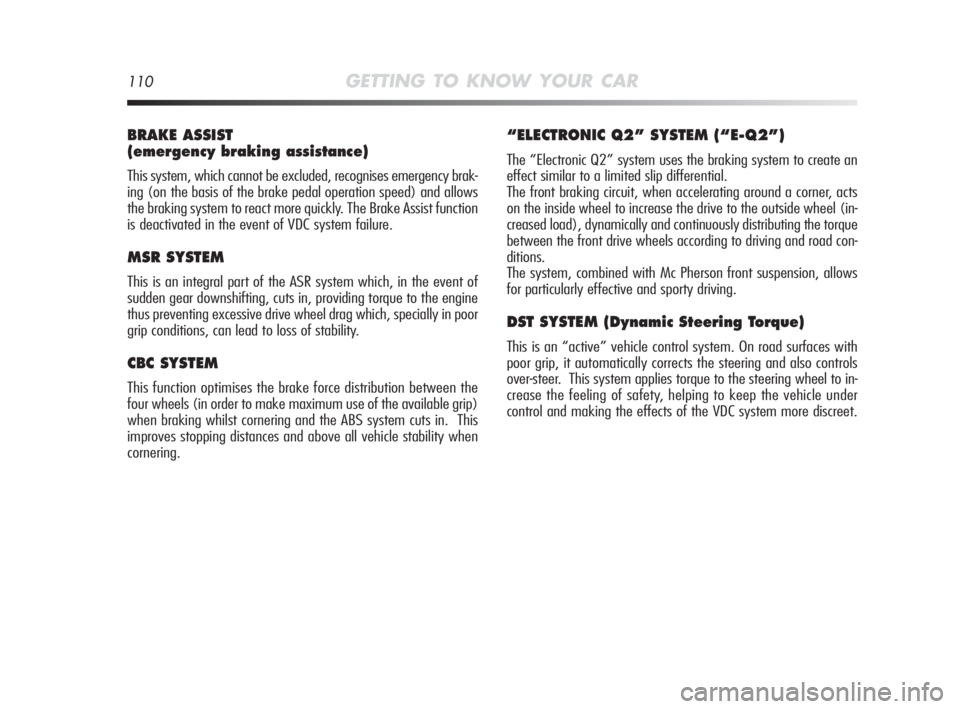
110GETTING TO KNOW YOUR CAR
BRAKE ASSIST
(emergency braking assistance)
This system, which cannot be excluded, recognises emergency brak-
ing (on the basis of the brake pedal operation speed) and allows
the braking system to react more quickly. The Brake Assist function
is deactivated in the event of VDC system failure.
MSR SYSTEM
This is an integral part of the ASR system which, in the event of
sudden gear downshifting, cuts in, providing torque to the engine
thus preventing excessive drive wheel drag which, specially in poor
grip conditions, can lead to loss of stability.
CBC SYSTEM
This function optimises the brake force distribution between the
four wheels (in order to make maximum use of the available grip)
when braking whilst cornering and the ABS system cuts in. This
improves stopping distances and above all vehicle stability when
cornering.
“ELECTRONIC Q2” SYSTEM (“E-Q2”)
The “Electronic Q2” system uses the braking system to create an
effect similar to a limited slip differential.
The front braking circuit, when accelerating around a corner, acts
on the inside wheel to increase the drive to the outside wheel (in-
creased load), dynamically and continuously distributing the torque
between the front drive wheels according to driving and road con-
ditions.
The system, combined with Mc Pherson front suspension, allows
for particularly effective and sporty driving.
DST SYSTEM (Dynamic Steering Torque)
This is an “active” vehicle control system. On road surfaces with
poor grip, it automatically corrects the steering and also controls
over-steer. This system applies torque to the steering wheel to in-
crease the feeling of safety, helping to keep the vehicle under
control and making the effects of the VDC system more discreet.
001-130 Alfa MiTo GB 2ed 23-12-2009 12:36 Pagina 110
Page 112 of 262

GETTING TO KNOW YOUR CAR111
1“Alfa DNA” SYSTEM
(Dynamic vehicle control system)
(for versions/markets, where provided)
This device allows three different driving modes to be selected by
operating lever A-fig. 70 on the central tunnel.
❍d = Dynamic (sports driving mode);
❍n = Normal (normal driving mode);
❍a = All Weather (driving mode for poor grip conditions, i.e. rain
and snow on the road)
The device also acts on the dynamic vehicle control systems (en-
gine, steering, VDC system, instrument panel).
fig. 70A0J0090m
DRIVING MODES
Lever A-fig. 70 is a one-way switch, i.e. it always remains in the cen-
tral position. The selected driving mode is indicated by the corre-
sponding LED coming on in the panel and by an indication on the re-
configurable multifunctional display, as illustrated below:
A0J0227mA0J0290m
Dynamic Mode All Weather Mode
Normal Mode
When “NORMAL” mode is selected, no messages or symbols are
shown on the display.
VDCandASR: Standard calibration
Steering wheel tuning: Standard calibration
DST: Standard control of the brakes coordinated with ABS
Standard control of side acceleration
Steering wheel compensation: a slight pulse on the steer-
ing wheel tells on the driver to make a better manoeuvre
Engine: Standard response
001-130 Alfa MiTo GB 2ed 23-12-2009 12:36 Pagina 111
Page 113 of 262
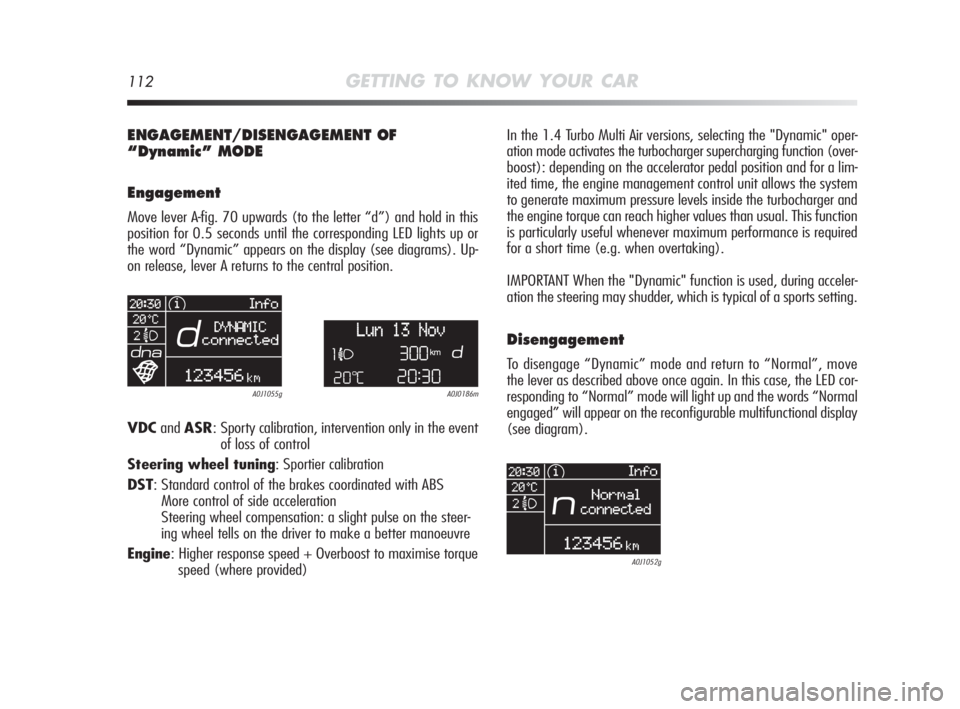
112GETTING TO KNOW YOUR CAR
ENGAGEMENT/DISENGAGEMENT OF
“Dynamic” MODE
Engagement
Move lever A-fig. 70 upwards (to the letter “d”) and hold in this
position for 0.5 seconds until the corresponding LED lights up or
the word “Dynamic” appears on the display (see diagrams). Up-
on release, lever A returns to the central position.
Disengagement
To disengage “Dynamic” mode and return to “Normal”, move
the lever as described above once again. In this case, the LED cor-
responding to “Normal” mode will light up and the words “Normal
engaged” will appear on the reconfigurable multifunctional display
(see diagram).
A0J0186mA0J1055g
A0J1052g
VDCandASR: Sporty calibration, intervention only in the event
of loss of control
Steering wheel tuning: Sportier calibration
DST: Standard control of the brakes coordinated with ABS
More control of side acceleration
Steering wheel compensation: a slight pulse on the steer-
ing wheel tells on the driver to make a better manoeuvre
Engine: Higher response speed + Overboost to maximise torque
speed (where provided)In the 1.4 Turbo Multi Air versions, selecting the "Dynamic" oper-
ation mode activates the turbocharger supercharging function (over-
boost): depending on the accelerator pedal position and for a lim-
ited time, the engine management control unit allows the system
to generate maximum pressure levels inside the turbocharger and
the engine torque can reach higher values than usual. This function
is particularly useful whenever maximum performance is required
for a short time (e.g. when overtaking).
IMPORTANT When the "Dynamic" function is used, during acceler-
ation the steering may shudder, which is typical of a sports setting.
001-130 Alfa MiTo GB 2ed 23-12-2009 12:36 Pagina 112
Page 114 of 262
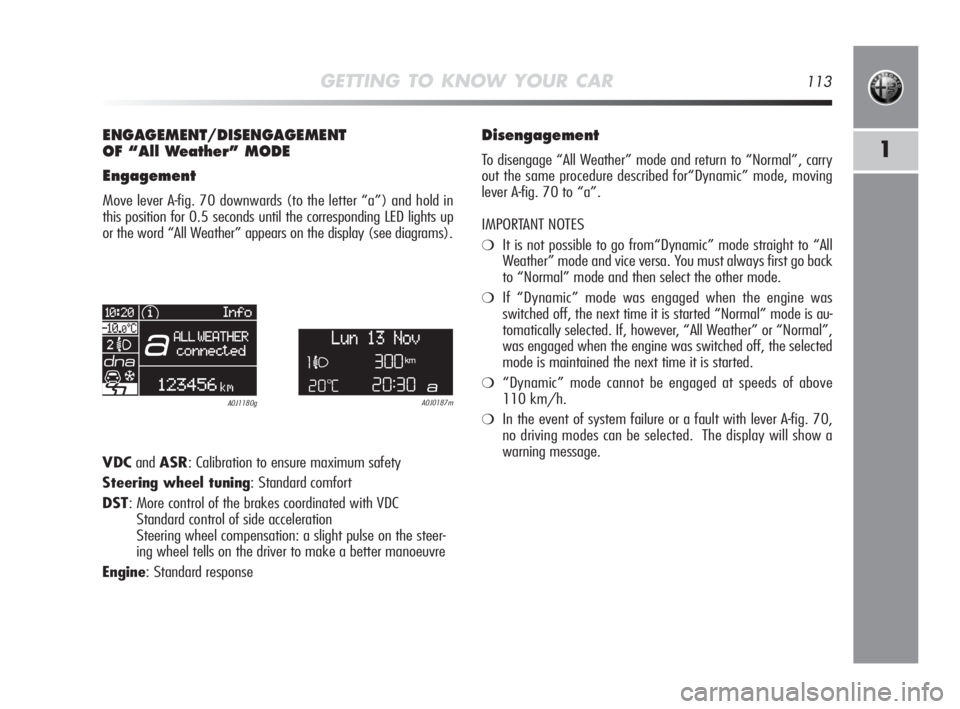
GETTING TO KNOW YOUR CAR113
1
ENGAGEMENT/DISENGAGEMENT
OF “All Weather” MODE
Engagement
Move lever A-fig. 70 downwards (to the letter “a”) and hold in
this position for 0.5 seconds until the corresponding LED lights up
or the word “All Weather” appears on the display (see diagrams).
A0J0187mA0J1180g
Disengagement
To disengage “All Weather” mode and return to “Normal”, carry
out the same procedure described for“Dynamic” mode, moving
lever A-fig. 70 to “a”.
IMPORTANT NOTES
❍It is not possible to go from“Dynamic” mode straight to “All
Weather” mode and vice versa. You must always first go back
to “Normal” mode and then select the other mode.
❍If “Dynamic” mode was engaged when the engine was
switched off, the next time it is started “Normal” mode is au-
tomatically selected. If, however, “All Weather” or “Normal”,
was engaged when the engine was switched off, the selected
mode is maintained the next time it is started.
❍“Dynamic” mode cannot be engaged at speeds of above
110 km/h.
❍In the event of system failure or a fault with lever A-fig. 70,
no driving modes can be selected. The display will show a
warning message.
VDCandASR: Calibration to ensure maximum safety
Steering wheel tuning: Standard comfort
DST: More control of the brakes coordinated with VDC
Standard control of side acceleration
Steering wheel compensation: a slight pulse on the steer-
ing wheel tells on the driver to make a better manoeuvre
Engine: Standard response
001-130 Alfa MiTo GB 2ed 23-12-2009 12:36 Pagina 113
Page 115 of 262

114GETTING TO KNOW YOUR CAR
NoteThe engine automatic stop is allowed only after having run
at about 10 km/h, to prevent repeated engine stops when driving
at a very slow speed. The engine stopping is signalled by display-
ing the
Usymbol in fig. 71.
Engine re-starting mode
To restart the engine, press the clutch pedal.
SYSTEM MANUAL ACTIVATION/DEACTIVATION
To activate/deactivate the system, press the button fig. 72 on
the trim next to the steering wheel. When the system is deacti-
vated, the
Uwarning light in the instrument panel switches on.
For versions/markets, where fitted, a message plus a symbol on
the display may appear in the event of activation/deactivation of
the system.
START&STOP SYSTEM
(for versions/markets, where provided)
The Start&Stop system stops the engine automatically when the
vehicle stops and starts it again when the driver wants to resume
driving. In this way, the vehicle efficiency is increased, by reduc-
ing consumption, dangerous gas emissions and sound pollution.
The system is active every time the engine is started.
OPERATING MODE
Engine stopping mode
With stopped vehicle, the engine stops with gearbox in neutral and
released clutch pedal.
fig. 71A0J0279mfig. 72A0J0247m
001-130 Alfa MiTo GB 2ed 23-12-2009 12:36 Pagina 114
Page 116 of 262
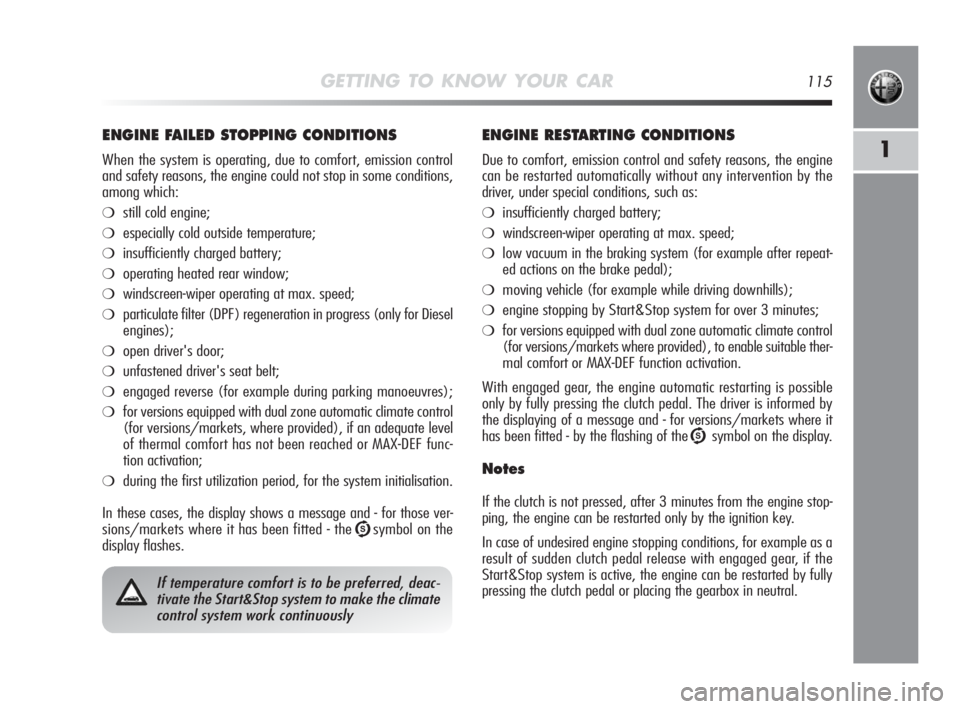
GETTING TO KNOW YOUR CAR115
1
ENGINE FAILED STOPPING CONDITIONS
When the system is operating, due to comfort, emission control
and safety reasons, the engine could not stop in some conditions,
among which:
❍still cold engine;
❍especially cold outside temperature;
❍insufficiently charged battery;
❍operating heated rear window;
❍windscreen-wiper operating at max. speed;
❍particulate filter (DPF) regeneration in progress (only for Diesel
engines);
❍open driver's door;
❍unfastened driver's seat belt;
❍engaged reverse (for example during parking manoeuvres);
❍for versions equipped with dual zone automatic climate control
(for versions/markets, where provided), if an adequate level
of thermal comfort has not been reached or MAX-DEF func-
tion activation;
❍during the first utilization period, for the system initialisation.
In these cases, the display shows a message and - for those ver-
sions/markets where it has been fitted - the
Usymbol on the
display flashes.
ENGINE RESTARTING CONDITIONS
Due to comfort, emission control and safety reasons, the engine
can be restarted automatically without any intervention by the
driver, under special conditions, such as:
❍insufficiently charged battery;
❍windscreen-wiper operating at max. speed;
❍low vacuum in the braking system (for example after repeat-
ed actions on the brake pedal);
❍moving vehicle (for example while driving downhills);
❍engine stopping by Start&Stop system for over 3 minutes;
❍for versions equipped with dual zone automatic climate control
(for versions/markets where provided), to enable suitable ther-
mal comfort or MAX-DEF function activation.
With engaged gear, the engine automatic restarting is possible
only by fully pressing the clutch pedal. The driver is informed by
the displaying of a message and - for versions/markets where it
has been fitted - by the flashing of the
Usymbol on the display.
Notes
If the clutch is not pressed, after 3 minutes from the engine stop-
ping, the engine can be restarted only by the ignition key.
In case of undesired engine stopping conditions, for example as a
result of sudden clutch pedal release with engaged gear, if the
Start&Stop system is active, the engine can be restarted by fully
pressing the clutch pedal or placing the gearbox in neutral.
If temperature comfort is to be preferred, deac-
tivate the Start&Stop system to make the climate
control system work continuously
001-130 Alfa MiTo GB 2ed 23-12-2009 12:36 Pagina 115
Page 117 of 262
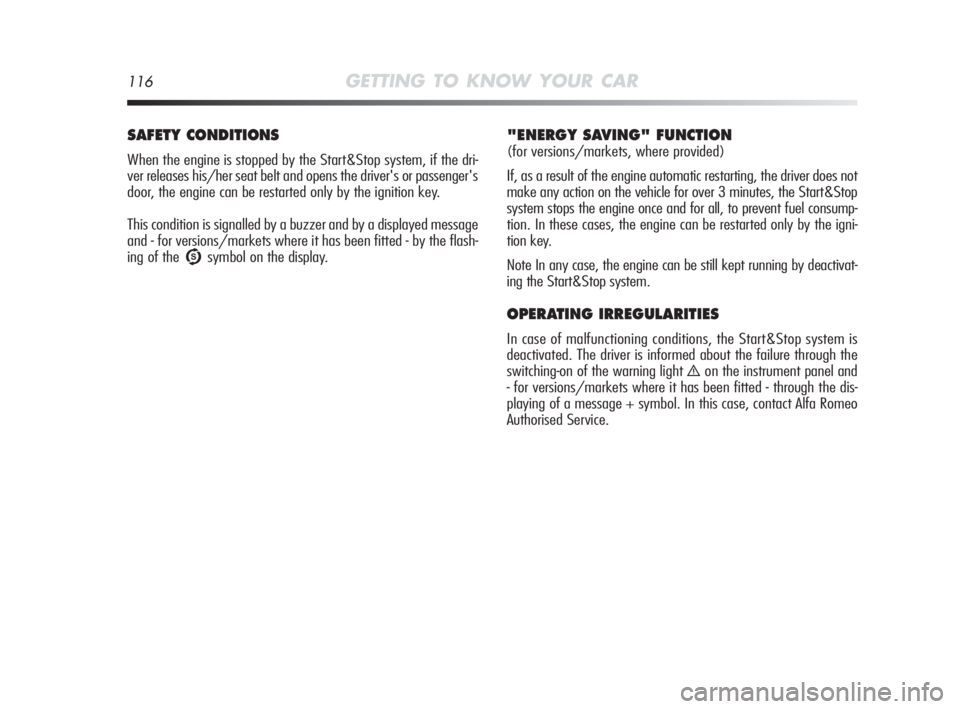
116GETTING TO KNOW YOUR CAR
SAFETY CONDITIONS
When the engine is stopped by the Start&Stop system, if the dri-
ver releases his/her seat belt and opens the driver's or passenger's
door, the engine can be restarted only by the ignition key.
This condition is signalled by a buzzer and by a displayed message
and - for versions/markets where it has been fitted - by the flash-
ing of the
Usymbol on the display.
"ENERGY SAVING" FUNCTION
(for versions/markets, where provided)
If, as a result of the engine automatic restarting, the driver does not
make any action on the vehicle for over 3 minutes, the Start&Stop
system stops the engine once and for all, to prevent fuel consump-
tion. In these cases, the engine can be restarted only by the igni-
tion key.
Note In any case, the engine can be still kept running by deactivat-
ing the Start&Stop system.
OPERATING IRREGULARITIES
In case of malfunctioning conditions, the Start&Stop system is
deactivated. The driver is informed about the failure through the
switching-on of the warning light
èon the instrument panel and
- for versions/markets where it has been fitted - through the dis-
playing of a message + symbol. In this case, contact Alfa Romeo
Authorised Service.
001-130 Alfa MiTo GB 2ed 23-12-2009 12:36 Pagina 116
Page 118 of 262

GETTING TO KNOW YOUR CAR117
1
CAR INACTIVITY
(with Start&Stop system with dummy pole)
(for versions/markets where provided)
In case of vehicle inactivity conditions, pay special attention to
the disconnection of the battery power supply. The procedure must
be made by disconnecting the quick release negative terminal
A-fig. 73 from the dummy negative pole B, as the battery nega-
tive pole C has a sensor D for battery condition monitoring that
must never be disconnected (unless the battery is replaced).
CAR INACTIVITY
(with Start&Stop system without dummy pole)
(for versions/markets where provided)
In case of car inactivity, special attention must be paid due to the
disconnection of the battery power supply. Proceed as follows:
detach the connector A-fig. 74 (by pressing button B) from sen-
sor C for monitoring the battery status installed on the battery neg-
ative pole D. This sensor should never be disconnected from the
pole except if the battery is replaced.
fig. 73A0J0249m
In case of battery replacement, always contact
Alfa Romeo Authorised Service. Replace the bat-
tery using a new one of the same type (HEAVY
DUTY) and having the same specifications.
fig. 74A0J0207m
001-130 Alfa MiTo GB 2ed 23-12-2009 12:36 Pagina 117
Page 119 of 262
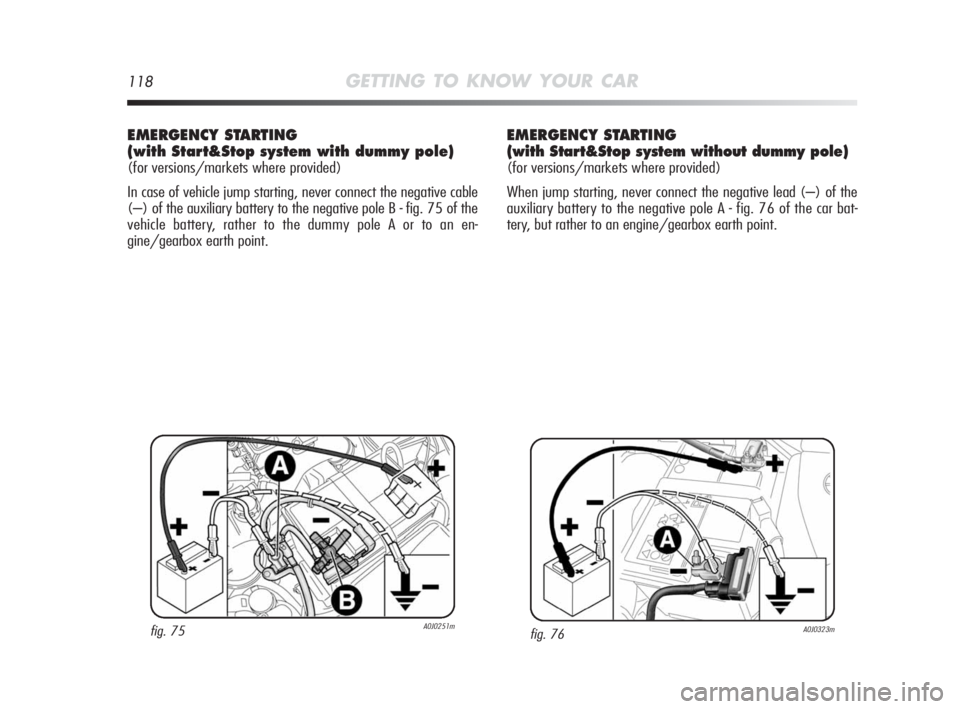
118GETTING TO KNOW YOUR CAR
EMERGENCY STARTING
(with Start&Stop system with dummy pole)
(for versions/markets where provided)
In case of vehicle jump starting, never connect the negative cable
(–) of the auxiliary battery to the negative pole B - fig. 75 of the
vehicle battery, rather to the dummy pole A or to an en-
gine/gearbox earth point.
fig. 75A0J0251m
EMERGENCY STARTING
(with Start&Stop system without dummy pole)
(for versions/markets where provided)
When jump starting, never connect the negative lead (–) of the
auxiliary battery to the negative pole A - fig. 76 of the car bat-
tery, but rather to an engine/gearbox earth point.
fig. 76A0J0323m
001-130 Alfa MiTo GB 2ed 23-12-2009 12:36 Pagina 118
Page 120 of 262
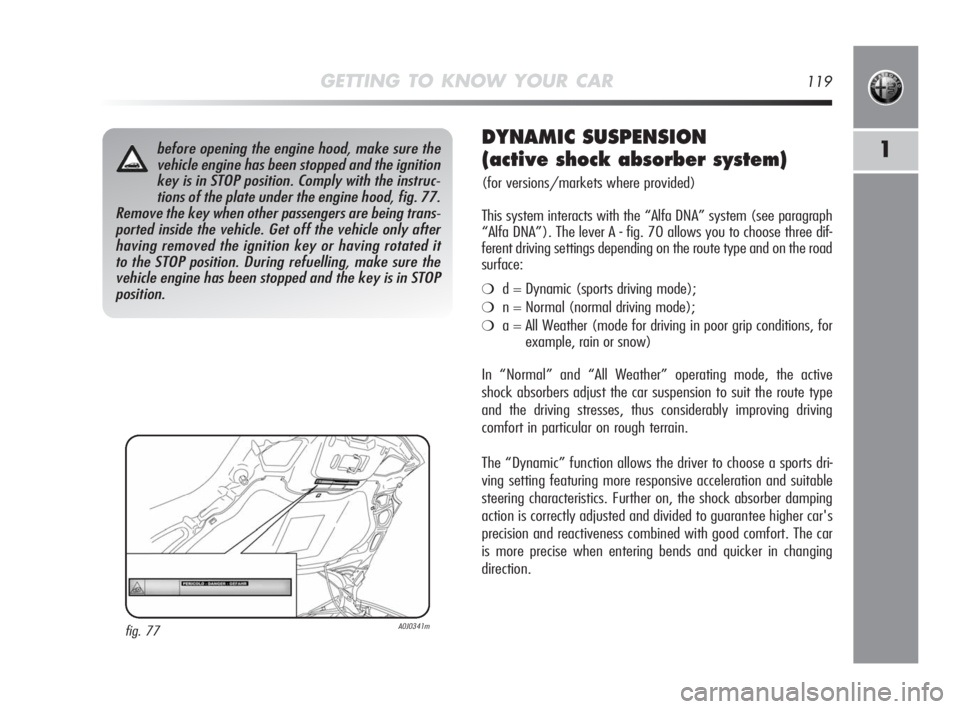
GETTING TO KNOW YOUR CAR119
1before opening the engine hood, make sure the
vehicle engine has been stopped and the ignition
key is in STOP position. Comply with the instruc-
tions of the plate under the engine hood, fig. 77.
Remove the key when other passengers are being trans-
ported inside the vehicle. Get off the vehicle only after
having removed the ignition key or having rotated it
to the STOP position. During refuelling, make sure the
vehicle engine has been stopped and the key is in STOP
position.
fig. 77A0J0341m
DYNAMIC SUSPENSION
(active shock absorber system)
(for versions/markets where provided)
This system interacts with the “Alfa DNA” system (see paragraph
“Alfa DNA”). The lever A - fig. 70 allows you to choose three dif-
ferent driving settings depending on the route type and on the road
surface:
❍d = Dynamic (sports driving mode);
❍n = Normal (normal driving mode);
❍a = All Weather (mode for driving in poor grip conditions, for
example, rain or snow)
In “Normal” and “All Weather” operating mode, the active
shock absorbers adjust the car suspension to suit the route type
and the driving stresses, thus considerably improving driving
comfort in particular on rough terrain.
The “Dynamic” function allows the driver to choose a sports dri-
ving setting featuring more responsive acceleration and suitable
steering characteristics. Further on, the shock absorber damping
action is correctly adjusted and divided to guarantee higher car's
precision and reactiveness combined with good comfort. The car
is more precise when entering bends and quicker in changing
direction.
001-130 Alfa MiTo GB 2ed 23-12-2009 12:36 Pagina 119